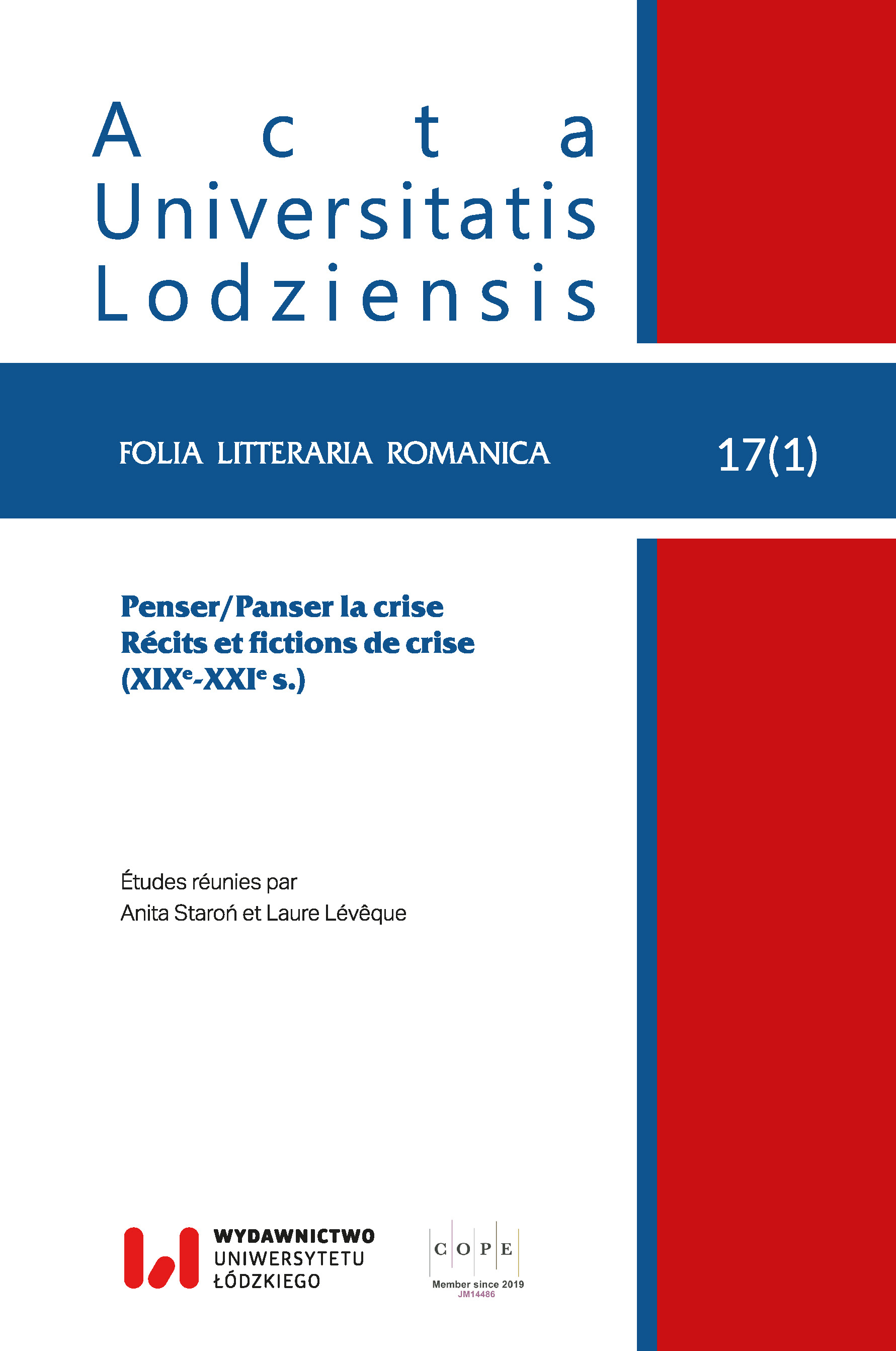Externalize the Intimacy or the Permanent Crisis of the Theater. Roland Dubillard’s "House of Bones": “Polyphonic Monodrama”?
DOI:
https://doi.org/10.18778/1505-9065.17.1.12Keywords:
Roland Dubillard, “absolute drama”, crisis of the theater, “rhapsodic dramaturgy”, “polyphonic drama”Abstract
Rolland Dubillard’s House of Bones is openly situated in the wake of “rhapsodic dramaturgy” which challenges the constraints of the canonical form that Szondi has defined as “absolute drama”. Not being based on a great conflict, the construction of the work does not respect the dynamics of the action (incidentally, non-existent), while focusing on the confrontation of a protagonist with oneself. Thus, the intersubjective, on which a traditional play is built, gives way to the extrasubjective which manifests itself, in this case, through a polyphonic monodrama. In fact, by studying Dubillard’s text, we see that the French author renounces the old paradigm in order to explore better the interiority of the main character. He leads a solitary life, surrounded by his many servants who seem to be the pale reflections of his torn soul. Freeing himself from the monologue, the writer conceives in this way a monodrama with several voices. This process does not, however, signify the crisis of the genre, because it constitutes one of the solutions allowing its evolution.
Downloads
References
Dubillard, Roland, La Maison d’os, Paris, Gallimard, 1966
Google Scholar
Aron, Paul, « Mimodrame et monodrame : deux formes méconnues de la crise du théâtre », Études théâtrales, 1999, no 15-16, p. 178-191
Google Scholar
Artaud, Antonin, Le Théâtre et son double, Paris, Gallimard, 1938, rééd. 1964, 1985
Google Scholar
Bernard-Gresh, Sylviane, « La Maison d’os », Télérama, 1 avril 2013, https://www.theatredurondpoint.fr/spectacle/la-maison-dos/ consulté le 3.05.2021
Google Scholar
Birgé, Jean-Jacques, « La Maison d’os, c’est Dubillard ! », Mediapart, 2 avril 2013, https://blogs.mediapart.fr/jean-jacques-birge/blog/010413/la-maison-dos-cest-dubillard consulté le 3.05.2021
Google Scholar
Blanchot, Maurice, L’Espace littéraire, Paris, Gallimard, 1955
Google Scholar
Blanchot, Maurice, L’Écriture du désastre, Paris, Gallimard, 1980
Google Scholar
Corvin, Michel, « Le dedans et le dehors ou l’être-là dans le théâtre de Roland Dubillard », Europe, 2018, no 1065-1066, p. 11-28
Google Scholar
Corvin, Michel, « Roland Dubillard », in Dictionnaire encyclopédique du théâtre, éd. M. Corvin, Paris, Larousse, 2001, p. 533-534
Google Scholar
Danan, Joseph, « Monodrame (polyphonique) », in Lexique du drame moderne et contemporain, éd. J.-P. Sarrazac, Circé, 2010, p. 122-124
Google Scholar
Dejean, Jean-Luc, Le théâtre français d’aujourd’hui, Paris, Fernand Nathan, 1971
Google Scholar
Garcin-Marrou, Flore, « Le drame émancipé », Études théâtrales, 2013, no 56-57, p. 171-181, https://doi.org/10.3917/etth.056.0171
Google Scholar
DOI: https://doi.org/10.3917/etth.056.0171
Gautier, Jean-Jacques, « La Maison d’os, de Roland Dubillard », Le Figaro, 23 novembre 1962 https://doi.org/10.1051/jphysrad:01962002302010500
Google Scholar
DOI: https://doi.org/10.1051/jphysrad:01962002302010500
Green, André, Un œil en trop : le complexe d’Œdipe dans la tragédie, Paris, Éditions de Minuit, 1969
Google Scholar
Ionesco, Eugène, Notes et contre-notes, Paris, Gallimard, 1966
Google Scholar
Járay-Benn, Csilla, « Les objets-personnages et les personnages-objets de Rolland Dubillard. La mobilité des objets dans les œuvres théâtrales », Revue d’esthétique 34, 1998, p. 267-284
Google Scholar
Klieger Stillman, Linda, « Doubling of Sign and Image in Roland Dubillard’s La Maison d’ os », SubStance, 1979, no 1, issue 22, p. 85-95, https://doi.org/10.2307/3684145
Google Scholar
DOI: https://doi.org/10.2307/3684145
Poudevigne, Sonia, La Théâtralité ou le théâtre dans la vie chez Nicolas Evreinov, Éditions universitaires européennes, 2019
Google Scholar
Ryngaert, Jean-Pierre, Sermon, Julie, Le Personnage théâtral contemporain : décomposition, recomposition, Montreuil, Éditions Théâtrales, 2006
Google Scholar
Sarraute, Claude, « La Maison d’os : une pièce sur l’abandon de la mort ? », France-Observateur, 29 novembre 1962, in « Roland Dubillard », Revue d’esthétique, 1998, 34, p. 319-320
Google Scholar
Sarrazac, Jean-Pierre, L’Avenir du drame, Lausanne, Éditions de l’Aire, 1981
Google Scholar
Sarrazac, Jean-Pierre, Poétique du drame moderne. De Henrik Ibsen à Bernard-Marie Koltès, Paris, Éditions du Seuil, 2012
Google Scholar
Sarrazac, Jean-Pierre, Théâtres intimes, Paris, Actes Sud, 1989
Google Scholar
Serreau, Geneviève, Histoire du « nouveau théâtre », Paris, Gallimard, 1966
Google Scholar
Szondi, Peter, Théorie du drame moderne, [trad. P. Pavis, Lausanne, L’Âge d’Homme, 1983] Belval, Circé, coll. « Penser le théâtre », 2006.
Google Scholar
Wilkinson, Robin, « Roland Dubillard, auteur de théâtre », Revue d’esthétique, 1998, 34, p. 199-219
Google Scholar
Wilkinson, Robin, Le Théâtre de Roland Dubillard, essai d’analyse sémiologique, Berne, P. Lang, 1989
Google Scholar
Published
How to Cite
Issue
Section
License

This work is licensed under a Creative Commons Attribution-NonCommercial-NoDerivatives 4.0 International License.













